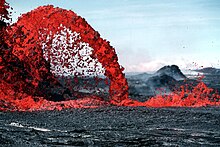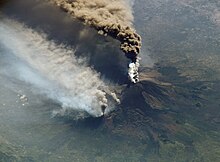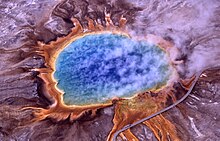Hot topics with WikiProject Volcanoes





This week, we had an explosive visit with WikiProject Volcanoes. Started in 2007, the project has grown to include almost 4,000 pages, including 25 featured articles, 3 featured lists, and 40 good articles. The project's total number of members is healthy, with around 25 active contributors, however, the project is seeking new participants. The project maintains a featured portal, in addition. We interviewed Resident Mario, Ceranthor, Volcanoguy, and Avenue.
What motivated you to become a member of WikiProject Volcanoes?
- Resident Mario: One of the things I love most about writing in this topic area is that it's very open. The United States Geological Service posts a good majority of their publications online, and contrary to what you expect, writing in the area isn't "heavy science" at all. The Global Volcanism Program is very comprehensive as well.
- Ceranthor: Volcanology has always been a hobby of mine. When I joined WikiProject Volcanoes, I noted that the project had an array of featured and good content under its belt, and my goal was, from the start, to expand upon that. The quality content in the area is mostly on major volcanoes, so I wanted to work on some of the lesser-known but powerful ones. The WikiProject provided a great opportunity to collaborate with others to reach these goals.
- Volcanoguy: A long-time and main contributor to Canadian volcano articles. Igneous petrology has been my favorite topic for over 5 years. I started editing the English Wikipedia in 2006 to expand and create articles related to volcanism. At first, Canada had a very limited amount of volcanological information. It was in horrible condition for a country that has over 100 volcanoes and 1000s of other magmatic features. My goal is to help increase the sparse knowledge of Canadian volcanism, though I sometimes expand/create articles for volcanological features outside of Canada and volcanic-associated mineralization throughout Canada.
- Avenue: I've loved volcanoes since I was a teenager, so when I saw someone starting a project on the topic, I thought it looked like fun. And it has been.
Have you contributed to one of the project's recognized articles (GA, A, FA, FL, etc.)? Share your experience.
- Resident Mario: Plenty. I keep a full list here. I've written 7 good articles, 1 Featured article (Loihi Seamount), 1 Featured list (List of volcanoes in the Hawaiian – Emperor seamount chain), and 1 Featured portal (our very own Volcanoes portal). My area of expertise are seamounts and Hawaiian volcanoes, and of course I'm most proud of what I've done for those two parts of the project. Basically, seamounts now exist on Wikipedia, and Hawaiian volcanoes are in much better condition. Possible next stop: Alaska: the land of vast wilderness and very remote volcanics!
- Ceranthor: Yes, I have written four featured articles (Nevado del Ruiz, Cerro Azul (Chile volcano), David A. Johnston, and Armero tragedy) under the project's scope. I've also contributed to fourteen good articles (sixteen counting FAs) concerning a variety of volcano types, including supervolcanoes, stratovolcanoes, shield volcanoes, and even an article about a hotspot. My experience along the way has been exceptional. I found that there are lots of experts out there who are very capable in terms of copyediting and accuracy checking, as well as lots of non-experts willing to collaborate with others on volcano articles.
- Volcanoguy: Several. I began improving Canadian volcanism articles to GA class in 2007 while my FA contributions did not start until early 2010. So far, I have brung 6 Canadian volcanism articles to GA class and 3 to FA class, one of which is currently at FAC.
- Avenue: I helped bring Nevado del Ruiz to FA class, and more recently our list of largest volcanic eruptions to FL. It seems like FA standards are always increasing, so there's lots to be done to bring our existing FAs up to scratch, and I've tried to help save some from the chop at FAR. I've taken one volcano FP, too (inside the Tarawera rift).
Has your project developed particularly close relationships with any other projects?
- Resident Mario: Personally, I've developed a distant relationship with WikiProject Mountains and WikiProject Geology, and a rather close one with WikiProject Hawaii, as well as a rather monologous one with WikiProject Seamounts. Along the way I've met some very capable and committed users hammering away here and there.
- Ceranthor: I've found that other larger projects can be very helpful when looking for sources or input; however, I don't think I've made kept any lasting relationships with other projects other than the Volcanism of Hawaii workgroup.
- Volcanoguy: Though not necessarily projects, there are two workgroups (Volcanism of Hawaii Workgroup and Volcanism of Canada Workgroup) that have close connections with WikiProject Volcanoes.
What are WikiProject Volcanoes' most pressing needs? How can a new contributor help today?
- Resident Mario: I gave an outline, more or less, of our coverage gaps here. The project suffers most IMO from a lack of eruptive coverage; highly important and impactful eruptions like the 1815 eruption of Mount Tambora and the 1991 eruption of Mount Pinatubo (a redirect) only exist as sections of their respective volcanoes articles, often taking up the bulk of the article! It naught aught be, and they would make very easy targets for users looking for a DYK credit or two. The other big issues is the coverage gap in volcanologists and the relative staleness of Lists of volcanoes.
- Volcanoguy: There are gaps all over the place. Over half of the project's articles are either stub or start class, especially ones that cover notable volcanoes and volcanological topics.
- Avenue: There's plenty left to do, especially if you look beyond recent volcanoes in English-speaking countries. We don't have much on regional patterns of volcanism yet (only five countries have articles: Canada, Chile, Iceland, Italy, and New Zealand). There are huge gaps in our coverage of submarine and extraterrestrial volcanoes, too.
Anything else you'd like to add?
- Resident Mario: New users are always needed. We're a work in progress, and the more users to help out, the better! You can fool all your friends that you're writing hard science while really just afixating your fascination with the hot red stuff :)
Next week, we'll visit a real archive. Feel free to browse ours in the meantime.


Discuss this story